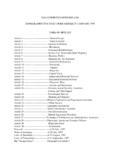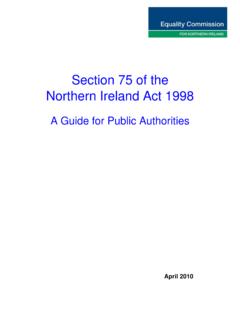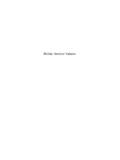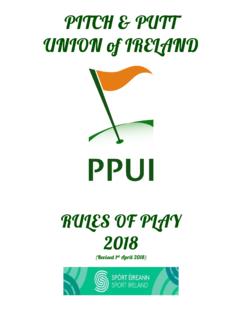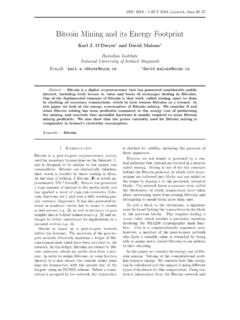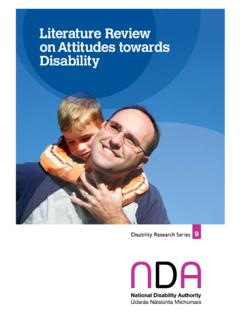Transcription of Control of radioactive substances - HSE: Information about ...
1 HSE Information sheet Control of radioactive substances Introduction This guidance has been written in association with the Environment Agency, the Scottish Environment Protection Agency, the Environment and Heritage Service and the Health and Safety Executive for Northern Ireland. This Information sheet is aimed at users of radioactive substances who are subject to the Ionising Radiations Regulations 1999 (IRR99), and the Ionising Radiations (Northern Ireland) Regulations 2000, and who also hold registrations or authorisations under the radioactive substances Act 1993 (RSA93). Any reference to IRR99 can be taken as also including the Northern Ireland Regulations. The Information sheet outlines some areas of similarity between IRR99 and RSA93 and the standards which will satisfy both sets of regulations. It does not give advice about other important aspects of IRR99 and RSA93 (see Further Information ) nor does it give advice on these two sets of legislation to those holding a licence under the Nuclear Installations Act 1965.
2 It is, however, relevant to employers (other than the licence holder) working on a site run by an organisation holding a licence under the Nuclear Installations Act 1965. It also provides Information on the European legislation controlling shipments of radioactive substances between EU Member States. Legislation IRR99 set down requirements for the safety of people who work with ionising radiations, including radioactive substances , and are enforced by the Health and Safety Executive (HSE) or in some cases by local authorities. RSA93 is enforced by the Environment Agency (EA) in England and Wales, the Scottish Environment Protection Agency (SEPA) in Scotland and the Environment and Heritage Service (EHS) in Northern Ireland. The primary purpose of RSA93 is to Control radioactive substances and in particular radioactive waste. It requires: registration with EA/SEPA/EHS for the keeping and use of radioactive materials and mobile radioactive apparatus; and authorisation by EA/SEPA/EHS for the accumulation and disposal of radioactive waste.
3 Some radioactive sources can be kept, used and disposed of without registration/authorisation provided they are held in accordance with the conditions of an exemption order under RSA93. Ionising Radiation Protection Series No 8 Notification, registration and authorisation Before you start work with radioactive substances for the first time, you will need to send details about that work to your local HSE office under IRR99. Normally you will also need to have applied for, and been granted, certificates of registration and/or authorisation under RSA93, by EA/SEPA/EHS. There are, however, some exemptions from these requirements. Please contact the appropriate agency if you need more advice. Anyone using radioactive substances in more than one of Scotland, Northern Ireland, England and Wales needs to register with each agency. Remember, if your company uses a radioactive substance owned by someone else, you still have to register. Management responsibilities Both IRR99 and RSA93 place management responsibilities on employers.
4 You may use existing management arrangements to comply with both sets of legal requirements. For example: Under the Management of Health and Safety at Work Regulations 1999 (and the Management of Health and Safety at Work Regulations (Northern Ireland) 2000), employers have a general responsibility to make arrangements for the planning, organisation, Control , monitoring and review of Control measures. Under IRR99, radiation employers must carry out a prior risk assessment before undertaking any activity involving work with radioactive substances and, for any areas designated as controlled, must prepare written local rules summarising the arrangements for controlling work with ionising radiations. Local rules may also be considered appropriate for supervised areas, depending on the nature of the work carried out there. Where local rules apply, a radiation protection supervisor (RPS) who is trained in the use of ionising radiation must be appointed to ensure that the arrangements set out in them are followed.
5 As a condition of registration or authorisation under RSA93, you will need to ensure there is adequate supervision by suitably qualified and experienced people to ensure compliance with registration and authorisation conditions. The same person(s) could act as RPS and provide the adequate supervision required by RSA93. However, the overall responsibility rests with the employer. You will probably need to consult, and possibly appoint, a suitable radiation protection adviser (RPA) under IRR99. Their advice will help you decide what must be done to meet IRR99. This might include preparing local rules, summarising the arrangements for controlling the work, and appointing radiation protection supervisors to ensure that the local rules are followed. The advice will also cover the need for prior risk assessment, contingency plans, dose assessment and, where appropriate, medical surveillance. The RPA might also be able to advise on compliance with RSA93, but you will need to ensure that they are competent to do so.
6 Under the Basic Safety Standards Directive there is a requirement for a qualified expert(s) to be employed in the discharge of duties related to the use and disposal of radioactive substances with respect to protection of the population and the environment. (The Basic Safety Standards Directive is a EURATOM Directive implemented in the UK by IRR99 and the Ionising Radiations Regulations (Northern Ireland) 2000, RSA93 and other national legislation.) The qualified expert will need to have relevant expertise, training and knowledge to ensure all requirements are met under RSA93. For many simple uses of radioactive material, an appointed RPA may have suitable expertise, but this will need to be agreed with the relevant agency. Keeping and accounting for radioactive substances You must have appropriate accounting procedures to ensure that the location of all radioactive substances is always known. Suitable procedures will enable you to identify radiologically significant losses quickly.
7 These procedures should include sufficient written/computer records to satisfy IRR99 and any conditions of registration/authorisation under RSA93. The type of Information to keep for these purposes should include: a means of identification, which for sealed sources should usually be unique; the date of receipt; the activity at a specified date; the whereabouts of the substance , updated at appropriate intervals; and the date and manner of proper disposal and to whom it was sent. It is advisable to carry out an annual audit of the arrangements to ensure that the accounting record is a true record, supported by records of ordering, receipt, stock and disposal of radioactive material. Routine checks on source location For radioactive sources securely attached to machines or other fixed equipment, checks may be carried out once a month provided that additional checks are carried out following any maintenance or repair which could have affected the source.
8 Records should be kept of these checks. If the source is portable, eg nuclear moisture/density gauges or site radiography containers, daily checks and records (on each working day the equipment is used) are recommended. In small-scale laboratories using open sources, it will be sufficient to know the radioactivity present and the radionuclides involved in each room, supported by records of ordering, receipt, stock and disposal of radioactive material. Leak tests Unless it is inappropriate to do so (the RPA will be able to advise you on this), you will need to ensure that any article containing or embodying a radioactive substance is tested for leakage of the radioactive substance . The interval between leak tests should not normally exceed two years. However, it is advisable to increase the frequency when a sealed source is going to be retained in use beyond the recommended working life given to the source capsule by the supplier or manufacturer.
9 The manufacturer or supplier will normally advise about periodic leak testing and the methods to adopt to give the required level of assurance that radioactive material will not be allowed to disperse. In the absence of such advice, test methods set out in ISO 9978 may be appropriate (see Further Information ). Keeping, moving and transporting radioactive substances You should normally keep radioactive sources, including any radioactive waste which is in storage, in suitable containers inside a suitable store to protect against accidental damage or loss and to protect employees and the general public. The container for the radioactive source(s) is likely to be suitable if it: is sufficiently secure to prevent loss/unauthorised exposure or dispersal; offers the protection needed to withstand damage from foreseeable use/misuse and fire; and provides adequate shielding to ensure the surface dose rate never exceeds 2 millisieverts per hour (usually it should be much less).
10 Note: This value is consistent with The radioactive Material (Road Transport) (Great Britain) Regulations 1996 for the maximum surface dose rate at any external surface of a package. The store is likely to be suitable if it: offers protection from the weather; has sufficient resistance to fire; provides shielding to achieve outside the store the lowest dose rate that is reasonably practicable. Where non-classified persons may approach the outside of the store it is advisable that the dose rate does not normally exceed microsieverts an hour. It may need to be lower in special cases if the employer wishes to avoid designating the area as a supervised area; provides adequate ventilation to prevent the build up of gases, vapours (whether radioactive or not) or of any accidentally dispersed radioactive substance ; offers proper physical security; and has a prominently displayed radiation warning sign which complies with the Health and Safety (Safety Signs and Signals) Regulations 1996.










